Education Curriculum Analysis: Te Tiriti o Waitangi and Maori Learners
VerifiedAdded on 2022/08/14
|12
|2758
|13
Essay
AI Summary
This essay delves into the significance of the Education Curriculum in the context of Aotearoa New Zealand, with a specific focus on the principles of Te Tiriti o Waitangi and its impact on Maori learners. The paper is divided into two parts; the first part explores the unique status of tangata whenua, the three core principles of Te Tiriti o Waitangi (partnership, protection, and participation), and their relevance within the education sector. The second part analyzes a specific strategy, the Ako strategy, which has been implemented to improve outcomes for Maori learners. It provides a critical analysis of the strategy, including its benefits and challenges, examples of its application in teaching practice, and how it aligns with the principles of Te Tiriti o Waitangi. The essay emphasizes the importance of incorporating Maori culture and perspectives into the education system to ensure equitable outcomes and a culturally responsive learning environment. The Ako strategy is presented as an example of how to foster the principle of participation as outlined in the Te Tiriti o Waitangi.
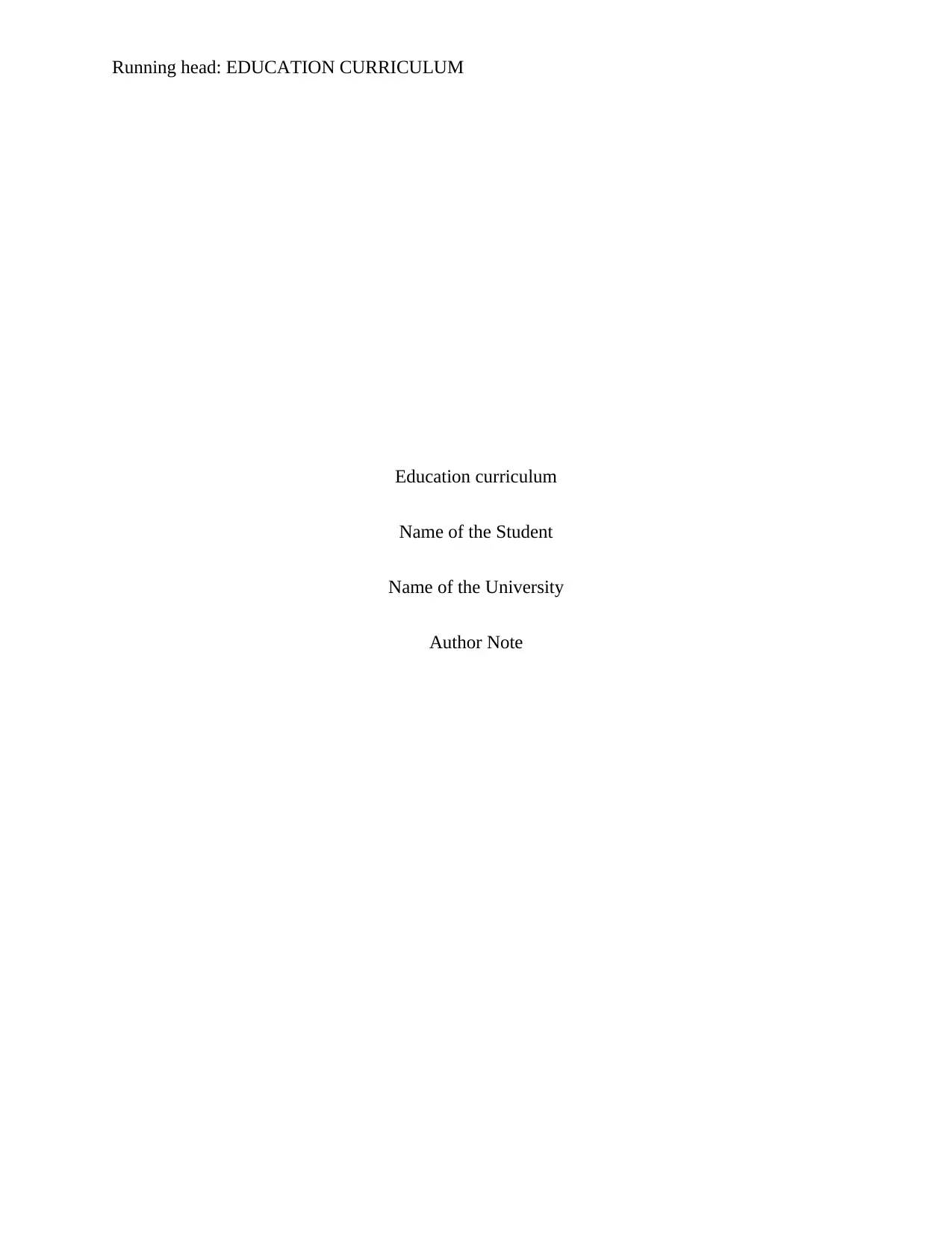
Running head: EDUCATION CURRICULUM
Education curriculum
Name of the Student
Name of the University
Author Note
Education curriculum
Name of the Student
Name of the University
Author Note
Paraphrase This Document
Need a fresh take? Get an instant paraphrase of this document with our AI Paraphraser
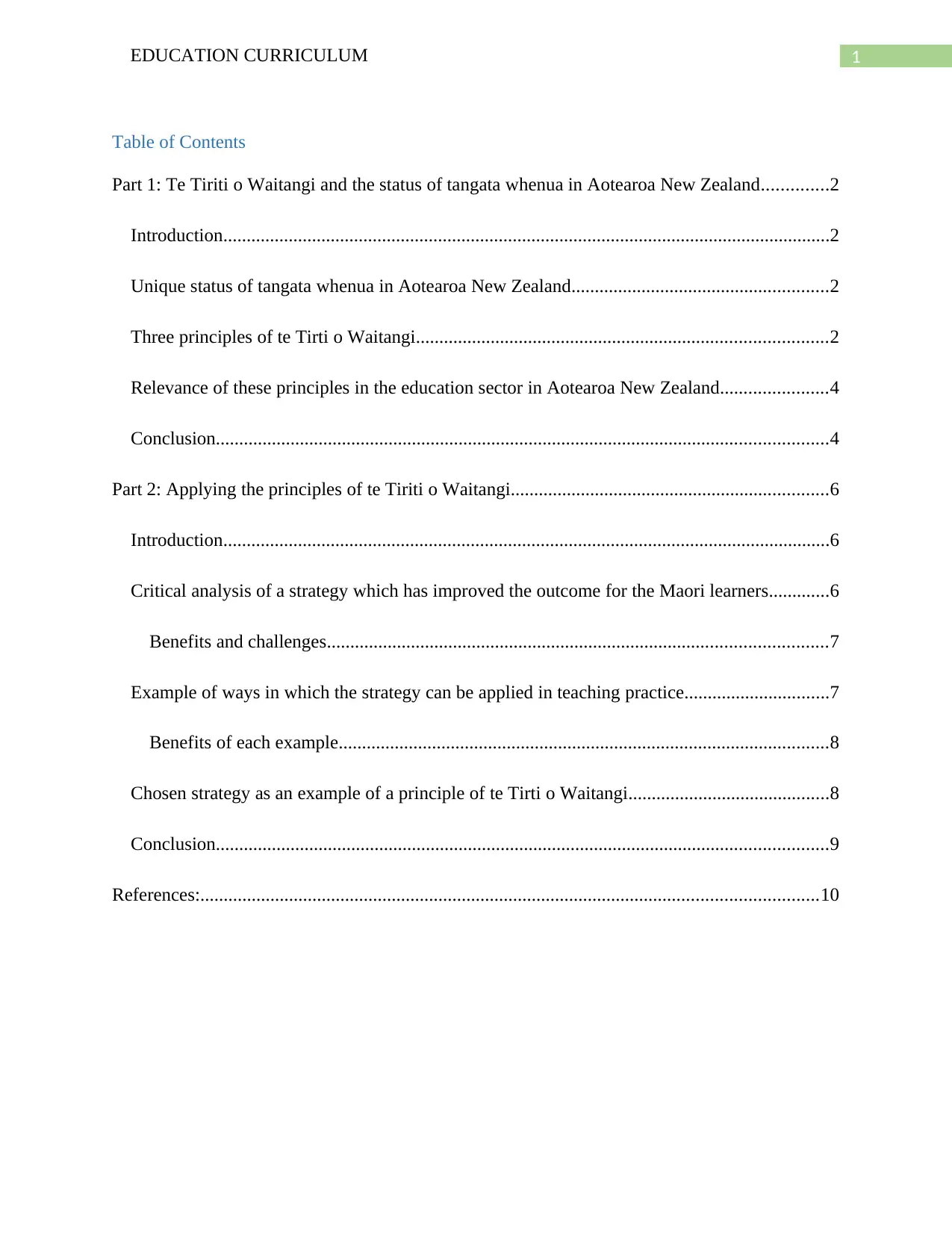
1EDUCATION CURRICULUM
Table of Contents
Part 1: Te Tiriti o Waitangi and the status of tangata whenua in Aotearoa New Zealand..............2
Introduction..................................................................................................................................2
Unique status of tangata whenua in Aotearoa New Zealand.......................................................2
Three principles of te Tirti o Waitangi........................................................................................2
Relevance of these principles in the education sector in Aotearoa New Zealand.......................4
Conclusion...................................................................................................................................4
Part 2: Applying the principles of te Tiriti o Waitangi....................................................................6
Introduction..................................................................................................................................6
Critical analysis of a strategy which has improved the outcome for the Maori learners.............6
Benefits and challenges...........................................................................................................7
Example of ways in which the strategy can be applied in teaching practice...............................7
Benefits of each example.........................................................................................................8
Chosen strategy as an example of a principle of te Tirti o Waitangi...........................................8
Conclusion...................................................................................................................................9
References:....................................................................................................................................10
Table of Contents
Part 1: Te Tiriti o Waitangi and the status of tangata whenua in Aotearoa New Zealand..............2
Introduction..................................................................................................................................2
Unique status of tangata whenua in Aotearoa New Zealand.......................................................2
Three principles of te Tirti o Waitangi........................................................................................2
Relevance of these principles in the education sector in Aotearoa New Zealand.......................4
Conclusion...................................................................................................................................4
Part 2: Applying the principles of te Tiriti o Waitangi....................................................................6
Introduction..................................................................................................................................6
Critical analysis of a strategy which has improved the outcome for the Maori learners.............6
Benefits and challenges...........................................................................................................7
Example of ways in which the strategy can be applied in teaching practice...............................7
Benefits of each example.........................................................................................................8
Chosen strategy as an example of a principle of te Tirti o Waitangi...........................................8
Conclusion...................................................................................................................................9
References:....................................................................................................................................10
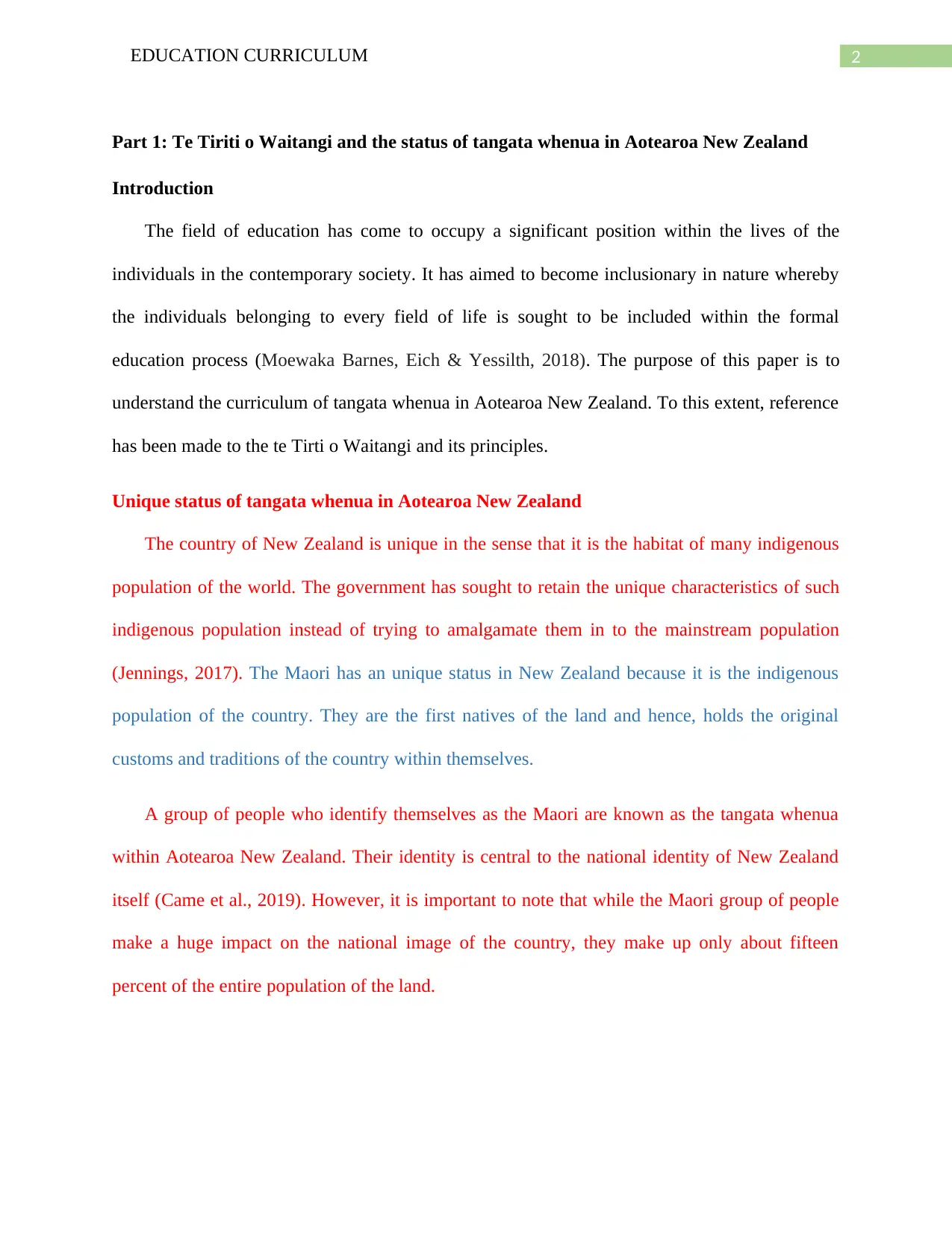
2EDUCATION CURRICULUM
Part 1: Te Tiriti o Waitangi and the status of tangata whenua in Aotearoa New Zealand
Introduction
The field of education has come to occupy a significant position within the lives of the
individuals in the contemporary society. It has aimed to become inclusionary in nature whereby
the individuals belonging to every field of life is sought to be included within the formal
education process (Moewaka Barnes, Eich & Yessilth, 2018). The purpose of this paper is to
understand the curriculum of tangata whenua in Aotearoa New Zealand. To this extent, reference
has been made to the te Tirti o Waitangi and its principles.
Unique status of tangata whenua in Aotearoa New Zealand
The country of New Zealand is unique in the sense that it is the habitat of many indigenous
population of the world. The government has sought to retain the unique characteristics of such
indigenous population instead of trying to amalgamate them in to the mainstream population
(Jennings, 2017). The Maori has an unique status in New Zealand because it is the indigenous
population of the country. They are the first natives of the land and hence, holds the original
customs and traditions of the country within themselves.
A group of people who identify themselves as the Maori are known as the tangata whenua
within Aotearoa New Zealand. Their identity is central to the national identity of New Zealand
itself (Came et al., 2019). However, it is important to note that while the Maori group of people
make a huge impact on the national image of the country, they make up only about fifteen
percent of the entire population of the land.
Part 1: Te Tiriti o Waitangi and the status of tangata whenua in Aotearoa New Zealand
Introduction
The field of education has come to occupy a significant position within the lives of the
individuals in the contemporary society. It has aimed to become inclusionary in nature whereby
the individuals belonging to every field of life is sought to be included within the formal
education process (Moewaka Barnes, Eich & Yessilth, 2018). The purpose of this paper is to
understand the curriculum of tangata whenua in Aotearoa New Zealand. To this extent, reference
has been made to the te Tirti o Waitangi and its principles.
Unique status of tangata whenua in Aotearoa New Zealand
The country of New Zealand is unique in the sense that it is the habitat of many indigenous
population of the world. The government has sought to retain the unique characteristics of such
indigenous population instead of trying to amalgamate them in to the mainstream population
(Jennings, 2017). The Maori has an unique status in New Zealand because it is the indigenous
population of the country. They are the first natives of the land and hence, holds the original
customs and traditions of the country within themselves.
A group of people who identify themselves as the Maori are known as the tangata whenua
within Aotearoa New Zealand. Their identity is central to the national identity of New Zealand
itself (Came et al., 2019). However, it is important to note that while the Maori group of people
make a huge impact on the national image of the country, they make up only about fifteen
percent of the entire population of the land.
⊘ This is a preview!⊘
Do you want full access?
Subscribe today to unlock all pages.

Trusted by 1+ million students worldwide
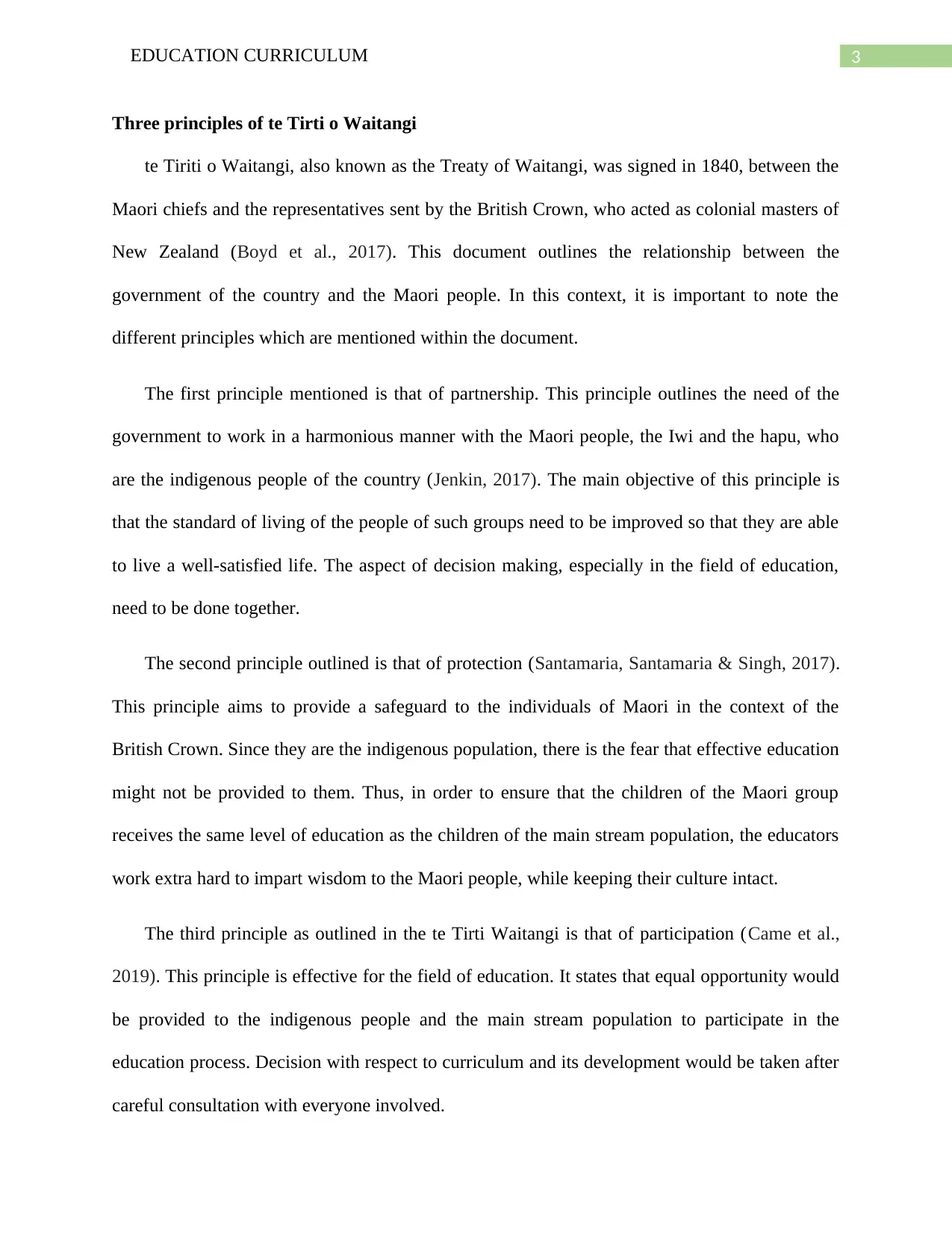
3EDUCATION CURRICULUM
Three principles of te Tirti o Waitangi
te Tiriti o Waitangi, also known as the Treaty of Waitangi, was signed in 1840, between the
Maori chiefs and the representatives sent by the British Crown, who acted as colonial masters of
New Zealand (Boyd et al., 2017). This document outlines the relationship between the
government of the country and the Maori people. In this context, it is important to note the
different principles which are mentioned within the document.
The first principle mentioned is that of partnership. This principle outlines the need of the
government to work in a harmonious manner with the Maori people, the Iwi and the hapu, who
are the indigenous people of the country (Jenkin, 2017). The main objective of this principle is
that the standard of living of the people of such groups need to be improved so that they are able
to live a well-satisfied life. The aspect of decision making, especially in the field of education,
need to be done together.
The second principle outlined is that of protection (Santamaria, Santamaria & Singh, 2017).
This principle aims to provide a safeguard to the individuals of Maori in the context of the
British Crown. Since they are the indigenous population, there is the fear that effective education
might not be provided to them. Thus, in order to ensure that the children of the Maori group
receives the same level of education as the children of the main stream population, the educators
work extra hard to impart wisdom to the Maori people, while keeping their culture intact.
The third principle as outlined in the te Tirti Waitangi is that of participation (Came et al.,
2019). This principle is effective for the field of education. It states that equal opportunity would
be provided to the indigenous people and the main stream population to participate in the
education process. Decision with respect to curriculum and its development would be taken after
careful consultation with everyone involved.
Three principles of te Tirti o Waitangi
te Tiriti o Waitangi, also known as the Treaty of Waitangi, was signed in 1840, between the
Maori chiefs and the representatives sent by the British Crown, who acted as colonial masters of
New Zealand (Boyd et al., 2017). This document outlines the relationship between the
government of the country and the Maori people. In this context, it is important to note the
different principles which are mentioned within the document.
The first principle mentioned is that of partnership. This principle outlines the need of the
government to work in a harmonious manner with the Maori people, the Iwi and the hapu, who
are the indigenous people of the country (Jenkin, 2017). The main objective of this principle is
that the standard of living of the people of such groups need to be improved so that they are able
to live a well-satisfied life. The aspect of decision making, especially in the field of education,
need to be done together.
The second principle outlined is that of protection (Santamaria, Santamaria & Singh, 2017).
This principle aims to provide a safeguard to the individuals of Maori in the context of the
British Crown. Since they are the indigenous population, there is the fear that effective education
might not be provided to them. Thus, in order to ensure that the children of the Maori group
receives the same level of education as the children of the main stream population, the educators
work extra hard to impart wisdom to the Maori people, while keeping their culture intact.
The third principle as outlined in the te Tirti Waitangi is that of participation (Came et al.,
2019). This principle is effective for the field of education. It states that equal opportunity would
be provided to the indigenous people and the main stream population to participate in the
education process. Decision with respect to curriculum and its development would be taken after
careful consultation with everyone involved.
Paraphrase This Document
Need a fresh take? Get an instant paraphrase of this document with our AI Paraphraser
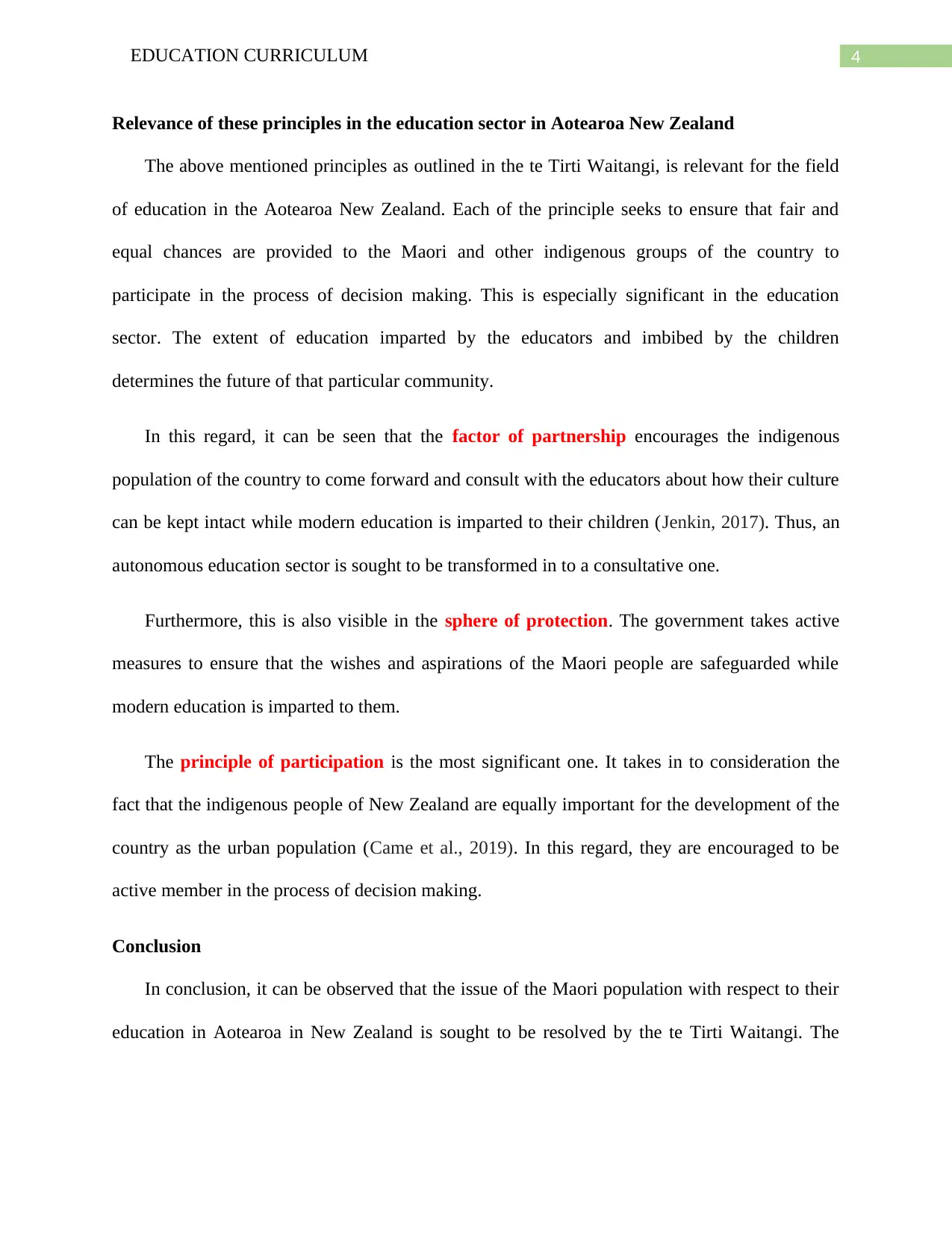
4EDUCATION CURRICULUM
Relevance of these principles in the education sector in Aotearoa New Zealand
The above mentioned principles as outlined in the te Tirti Waitangi, is relevant for the field
of education in the Aotearoa New Zealand. Each of the principle seeks to ensure that fair and
equal chances are provided to the Maori and other indigenous groups of the country to
participate in the process of decision making. This is especially significant in the education
sector. The extent of education imparted by the educators and imbibed by the children
determines the future of that particular community.
In this regard, it can be seen that the factor of partnership encourages the indigenous
population of the country to come forward and consult with the educators about how their culture
can be kept intact while modern education is imparted to their children (Jenkin, 2017). Thus, an
autonomous education sector is sought to be transformed in to a consultative one.
Furthermore, this is also visible in the sphere of protection. The government takes active
measures to ensure that the wishes and aspirations of the Maori people are safeguarded while
modern education is imparted to them.
The principle of participation is the most significant one. It takes in to consideration the
fact that the indigenous people of New Zealand are equally important for the development of the
country as the urban population (Came et al., 2019). In this regard, they are encouraged to be
active member in the process of decision making.
Conclusion
In conclusion, it can be observed that the issue of the Maori population with respect to their
education in Aotearoa in New Zealand is sought to be resolved by the te Tirti Waitangi. The
Relevance of these principles in the education sector in Aotearoa New Zealand
The above mentioned principles as outlined in the te Tirti Waitangi, is relevant for the field
of education in the Aotearoa New Zealand. Each of the principle seeks to ensure that fair and
equal chances are provided to the Maori and other indigenous groups of the country to
participate in the process of decision making. This is especially significant in the education
sector. The extent of education imparted by the educators and imbibed by the children
determines the future of that particular community.
In this regard, it can be seen that the factor of partnership encourages the indigenous
population of the country to come forward and consult with the educators about how their culture
can be kept intact while modern education is imparted to their children (Jenkin, 2017). Thus, an
autonomous education sector is sought to be transformed in to a consultative one.
Furthermore, this is also visible in the sphere of protection. The government takes active
measures to ensure that the wishes and aspirations of the Maori people are safeguarded while
modern education is imparted to them.
The principle of participation is the most significant one. It takes in to consideration the
fact that the indigenous people of New Zealand are equally important for the development of the
country as the urban population (Came et al., 2019). In this regard, they are encouraged to be
active member in the process of decision making.
Conclusion
In conclusion, it can be observed that the issue of the Maori population with respect to their
education in Aotearoa in New Zealand is sought to be resolved by the te Tirti Waitangi. The
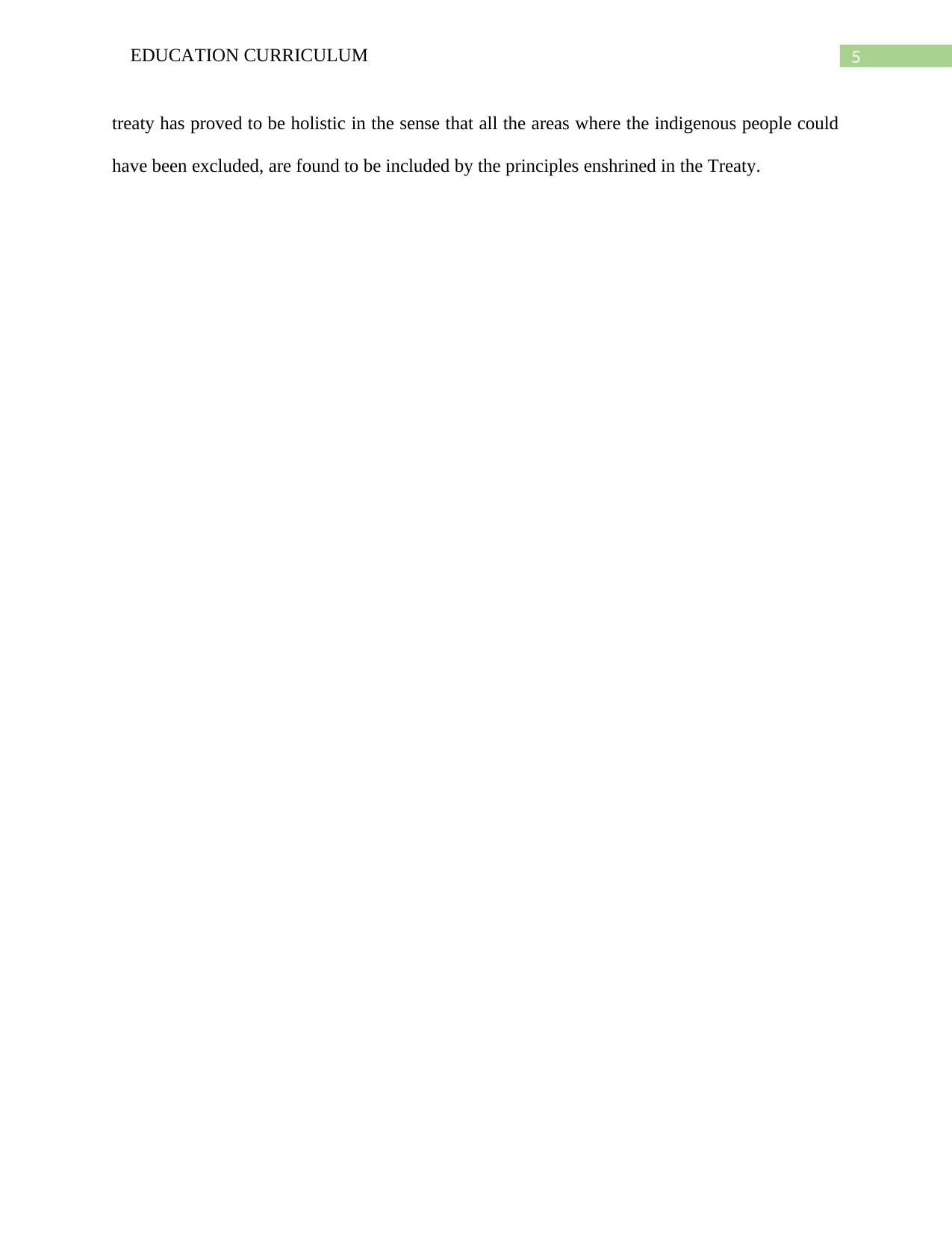
5EDUCATION CURRICULUM
treaty has proved to be holistic in the sense that all the areas where the indigenous people could
have been excluded, are found to be included by the principles enshrined in the Treaty.
treaty has proved to be holistic in the sense that all the areas where the indigenous people could
have been excluded, are found to be included by the principles enshrined in the Treaty.
⊘ This is a preview!⊘
Do you want full access?
Subscribe today to unlock all pages.

Trusted by 1+ million students worldwide
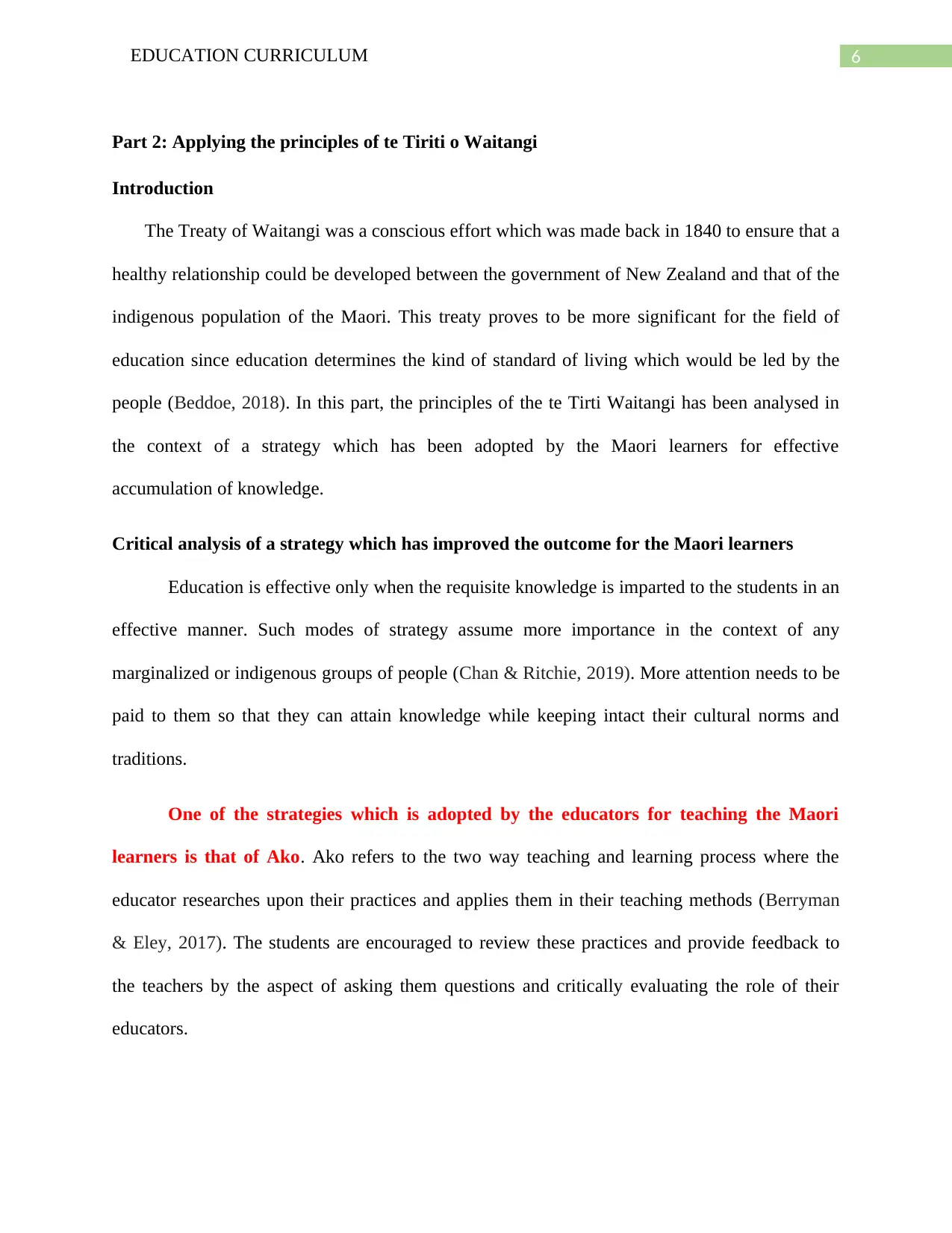
6EDUCATION CURRICULUM
Part 2: Applying the principles of te Tiriti o Waitangi
Introduction
The Treaty of Waitangi was a conscious effort which was made back in 1840 to ensure that a
healthy relationship could be developed between the government of New Zealand and that of the
indigenous population of the Maori. This treaty proves to be more significant for the field of
education since education determines the kind of standard of living which would be led by the
people (Beddoe, 2018). In this part, the principles of the te Tirti Waitangi has been analysed in
the context of a strategy which has been adopted by the Maori learners for effective
accumulation of knowledge.
Critical analysis of a strategy which has improved the outcome for the Maori learners
Education is effective only when the requisite knowledge is imparted to the students in an
effective manner. Such modes of strategy assume more importance in the context of any
marginalized or indigenous groups of people (Chan & Ritchie, 2019). More attention needs to be
paid to them so that they can attain knowledge while keeping intact their cultural norms and
traditions.
One of the strategies which is adopted by the educators for teaching the Maori
learners is that of Ako. Ako refers to the two way teaching and learning process where the
educator researches upon their practices and applies them in their teaching methods (Berryman
& Eley, 2017). The students are encouraged to review these practices and provide feedback to
the teachers by the aspect of asking them questions and critically evaluating the role of their
educators.
Part 2: Applying the principles of te Tiriti o Waitangi
Introduction
The Treaty of Waitangi was a conscious effort which was made back in 1840 to ensure that a
healthy relationship could be developed between the government of New Zealand and that of the
indigenous population of the Maori. This treaty proves to be more significant for the field of
education since education determines the kind of standard of living which would be led by the
people (Beddoe, 2018). In this part, the principles of the te Tirti Waitangi has been analysed in
the context of a strategy which has been adopted by the Maori learners for effective
accumulation of knowledge.
Critical analysis of a strategy which has improved the outcome for the Maori learners
Education is effective only when the requisite knowledge is imparted to the students in an
effective manner. Such modes of strategy assume more importance in the context of any
marginalized or indigenous groups of people (Chan & Ritchie, 2019). More attention needs to be
paid to them so that they can attain knowledge while keeping intact their cultural norms and
traditions.
One of the strategies which is adopted by the educators for teaching the Maori
learners is that of Ako. Ako refers to the two way teaching and learning process where the
educator researches upon their practices and applies them in their teaching methods (Berryman
& Eley, 2017). The students are encouraged to review these practices and provide feedback to
the teachers by the aspect of asking them questions and critically evaluating the role of their
educators.
Paraphrase This Document
Need a fresh take? Get an instant paraphrase of this document with our AI Paraphraser
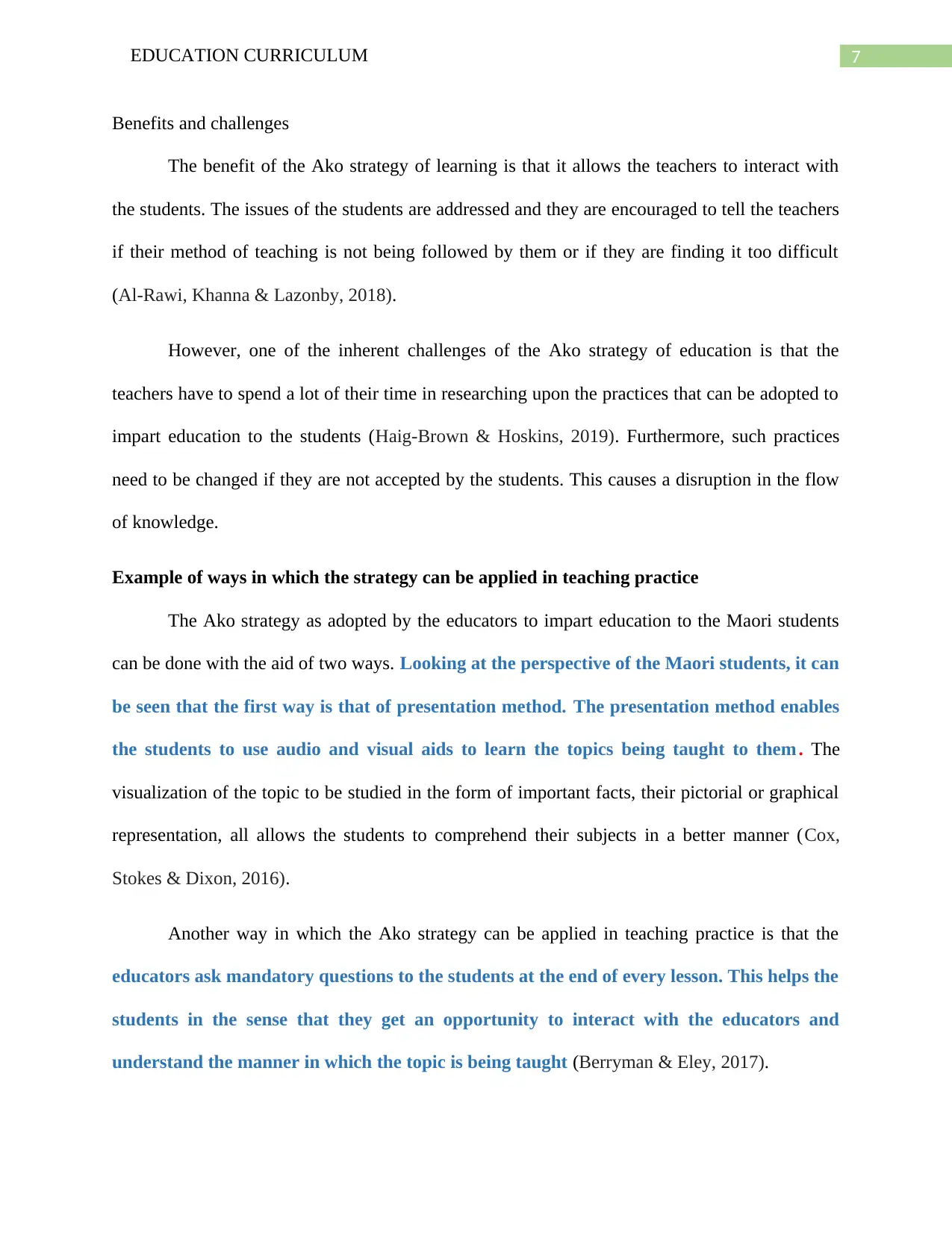
7EDUCATION CURRICULUM
Benefits and challenges
The benefit of the Ako strategy of learning is that it allows the teachers to interact with
the students. The issues of the students are addressed and they are encouraged to tell the teachers
if their method of teaching is not being followed by them or if they are finding it too difficult
(Al-Rawi, Khanna & Lazonby, 2018).
However, one of the inherent challenges of the Ako strategy of education is that the
teachers have to spend a lot of their time in researching upon the practices that can be adopted to
impart education to the students (Haig-Brown & Hoskins, 2019). Furthermore, such practices
need to be changed if they are not accepted by the students. This causes a disruption in the flow
of knowledge.
Example of ways in which the strategy can be applied in teaching practice
The Ako strategy as adopted by the educators to impart education to the Maori students
can be done with the aid of two ways. Looking at the perspective of the Maori students, it can
be seen that the first way is that of presentation method. The presentation method enables
the students to use audio and visual aids to learn the topics being taught to them . The
visualization of the topic to be studied in the form of important facts, their pictorial or graphical
representation, all allows the students to comprehend their subjects in a better manner (Cox,
Stokes & Dixon, 2016).
Another way in which the Ako strategy can be applied in teaching practice is that the
educators ask mandatory questions to the students at the end of every lesson. This helps the
students in the sense that they get an opportunity to interact with the educators and
understand the manner in which the topic is being taught (Berryman & Eley, 2017).
Benefits and challenges
The benefit of the Ako strategy of learning is that it allows the teachers to interact with
the students. The issues of the students are addressed and they are encouraged to tell the teachers
if their method of teaching is not being followed by them or if they are finding it too difficult
(Al-Rawi, Khanna & Lazonby, 2018).
However, one of the inherent challenges of the Ako strategy of education is that the
teachers have to spend a lot of their time in researching upon the practices that can be adopted to
impart education to the students (Haig-Brown & Hoskins, 2019). Furthermore, such practices
need to be changed if they are not accepted by the students. This causes a disruption in the flow
of knowledge.
Example of ways in which the strategy can be applied in teaching practice
The Ako strategy as adopted by the educators to impart education to the Maori students
can be done with the aid of two ways. Looking at the perspective of the Maori students, it can
be seen that the first way is that of presentation method. The presentation method enables
the students to use audio and visual aids to learn the topics being taught to them . The
visualization of the topic to be studied in the form of important facts, their pictorial or graphical
representation, all allows the students to comprehend their subjects in a better manner (Cox,
Stokes & Dixon, 2016).
Another way in which the Ako strategy can be applied in teaching practice is that the
educators ask mandatory questions to the students at the end of every lesson. This helps the
students in the sense that they get an opportunity to interact with the educators and
understand the manner in which the topic is being taught (Berryman & Eley, 2017).
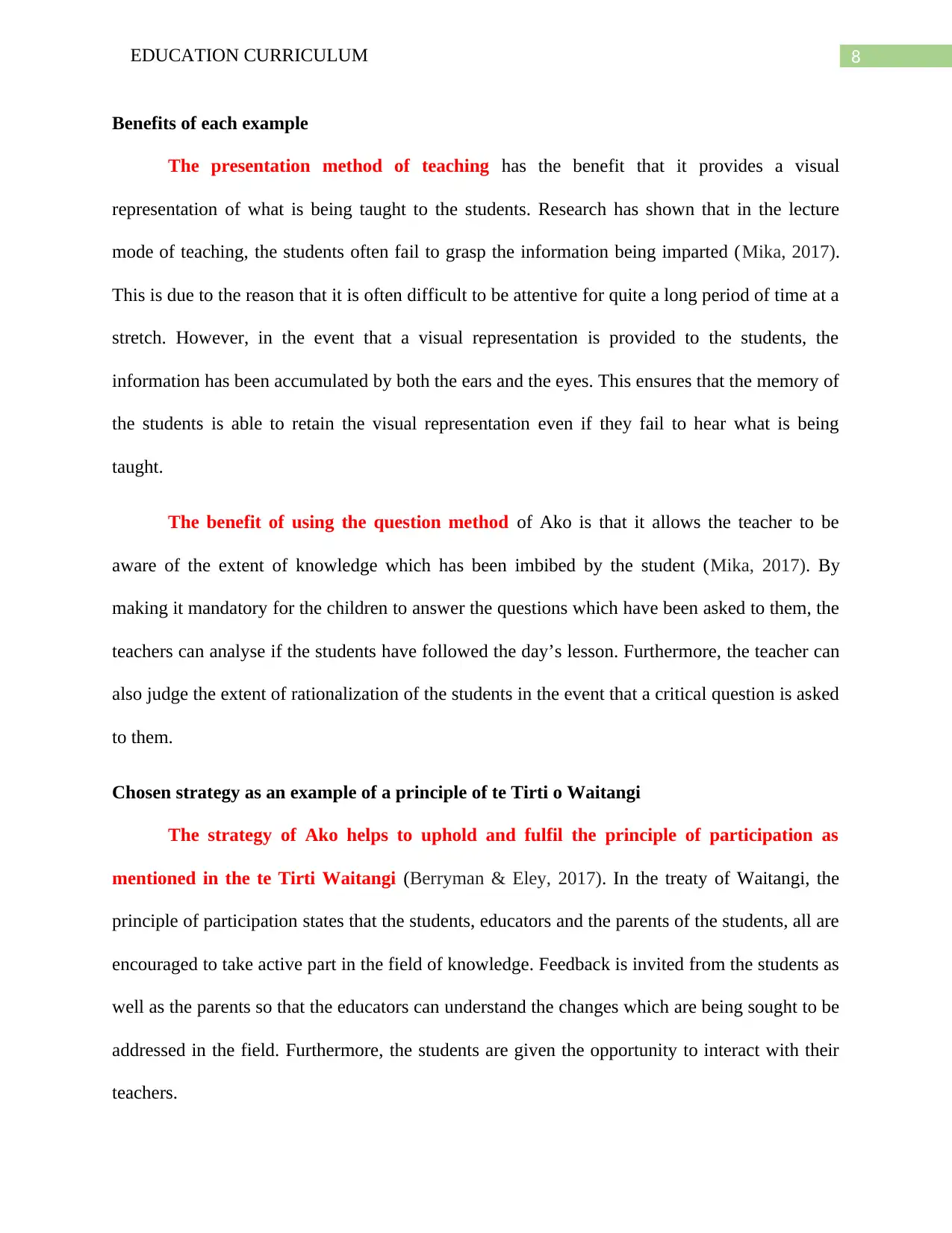
8EDUCATION CURRICULUM
Benefits of each example
The presentation method of teaching has the benefit that it provides a visual
representation of what is being taught to the students. Research has shown that in the lecture
mode of teaching, the students often fail to grasp the information being imparted (Mika, 2017).
This is due to the reason that it is often difficult to be attentive for quite a long period of time at a
stretch. However, in the event that a visual representation is provided to the students, the
information has been accumulated by both the ears and the eyes. This ensures that the memory of
the students is able to retain the visual representation even if they fail to hear what is being
taught.
The benefit of using the question method of Ako is that it allows the teacher to be
aware of the extent of knowledge which has been imbibed by the student (Mika, 2017). By
making it mandatory for the children to answer the questions which have been asked to them, the
teachers can analyse if the students have followed the day’s lesson. Furthermore, the teacher can
also judge the extent of rationalization of the students in the event that a critical question is asked
to them.
Chosen strategy as an example of a principle of te Tirti o Waitangi
The strategy of Ako helps to uphold and fulfil the principle of participation as
mentioned in the te Tirti Waitangi (Berryman & Eley, 2017). In the treaty of Waitangi, the
principle of participation states that the students, educators and the parents of the students, all are
encouraged to take active part in the field of knowledge. Feedback is invited from the students as
well as the parents so that the educators can understand the changes which are being sought to be
addressed in the field. Furthermore, the students are given the opportunity to interact with their
teachers.
Benefits of each example
The presentation method of teaching has the benefit that it provides a visual
representation of what is being taught to the students. Research has shown that in the lecture
mode of teaching, the students often fail to grasp the information being imparted (Mika, 2017).
This is due to the reason that it is often difficult to be attentive for quite a long period of time at a
stretch. However, in the event that a visual representation is provided to the students, the
information has been accumulated by both the ears and the eyes. This ensures that the memory of
the students is able to retain the visual representation even if they fail to hear what is being
taught.
The benefit of using the question method of Ako is that it allows the teacher to be
aware of the extent of knowledge which has been imbibed by the student (Mika, 2017). By
making it mandatory for the children to answer the questions which have been asked to them, the
teachers can analyse if the students have followed the day’s lesson. Furthermore, the teacher can
also judge the extent of rationalization of the students in the event that a critical question is asked
to them.
Chosen strategy as an example of a principle of te Tirti o Waitangi
The strategy of Ako helps to uphold and fulfil the principle of participation as
mentioned in the te Tirti Waitangi (Berryman & Eley, 2017). In the treaty of Waitangi, the
principle of participation states that the students, educators and the parents of the students, all are
encouraged to take active part in the field of knowledge. Feedback is invited from the students as
well as the parents so that the educators can understand the changes which are being sought to be
addressed in the field. Furthermore, the students are given the opportunity to interact with their
teachers.
⊘ This is a preview!⊘
Do you want full access?
Subscribe today to unlock all pages.

Trusted by 1+ million students worldwide
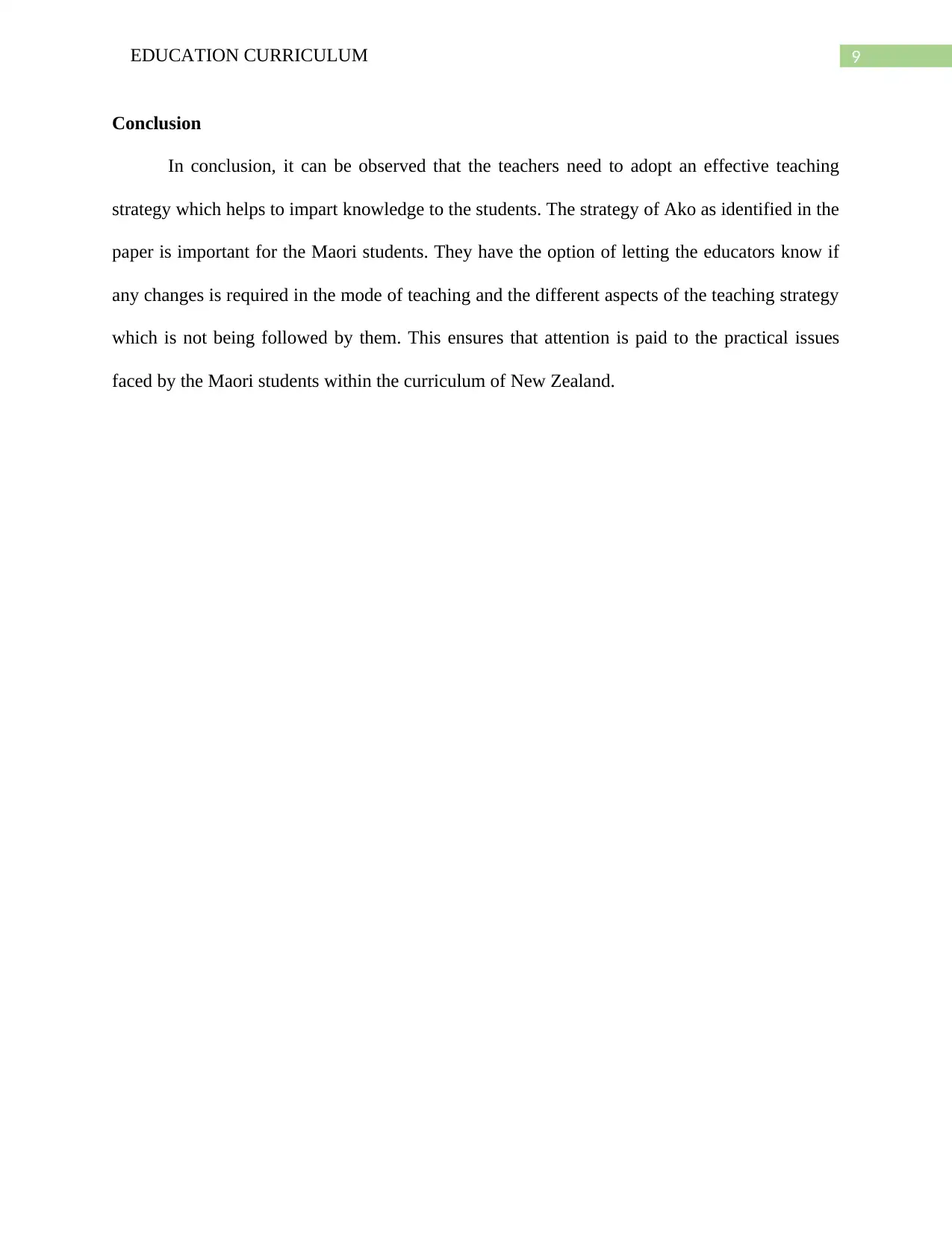
9EDUCATION CURRICULUM
Conclusion
In conclusion, it can be observed that the teachers need to adopt an effective teaching
strategy which helps to impart knowledge to the students. The strategy of Ako as identified in the
paper is important for the Maori students. They have the option of letting the educators know if
any changes is required in the mode of teaching and the different aspects of the teaching strategy
which is not being followed by them. This ensures that attention is paid to the practical issues
faced by the Maori students within the curriculum of New Zealand.
Conclusion
In conclusion, it can be observed that the teachers need to adopt an effective teaching
strategy which helps to impart knowledge to the students. The strategy of Ako as identified in the
paper is important for the Maori students. They have the option of letting the educators know if
any changes is required in the mode of teaching and the different aspects of the teaching strategy
which is not being followed by them. This ensures that attention is paid to the practical issues
faced by the Maori students within the curriculum of New Zealand.
Paraphrase This Document
Need a fresh take? Get an instant paraphrase of this document with our AI Paraphraser
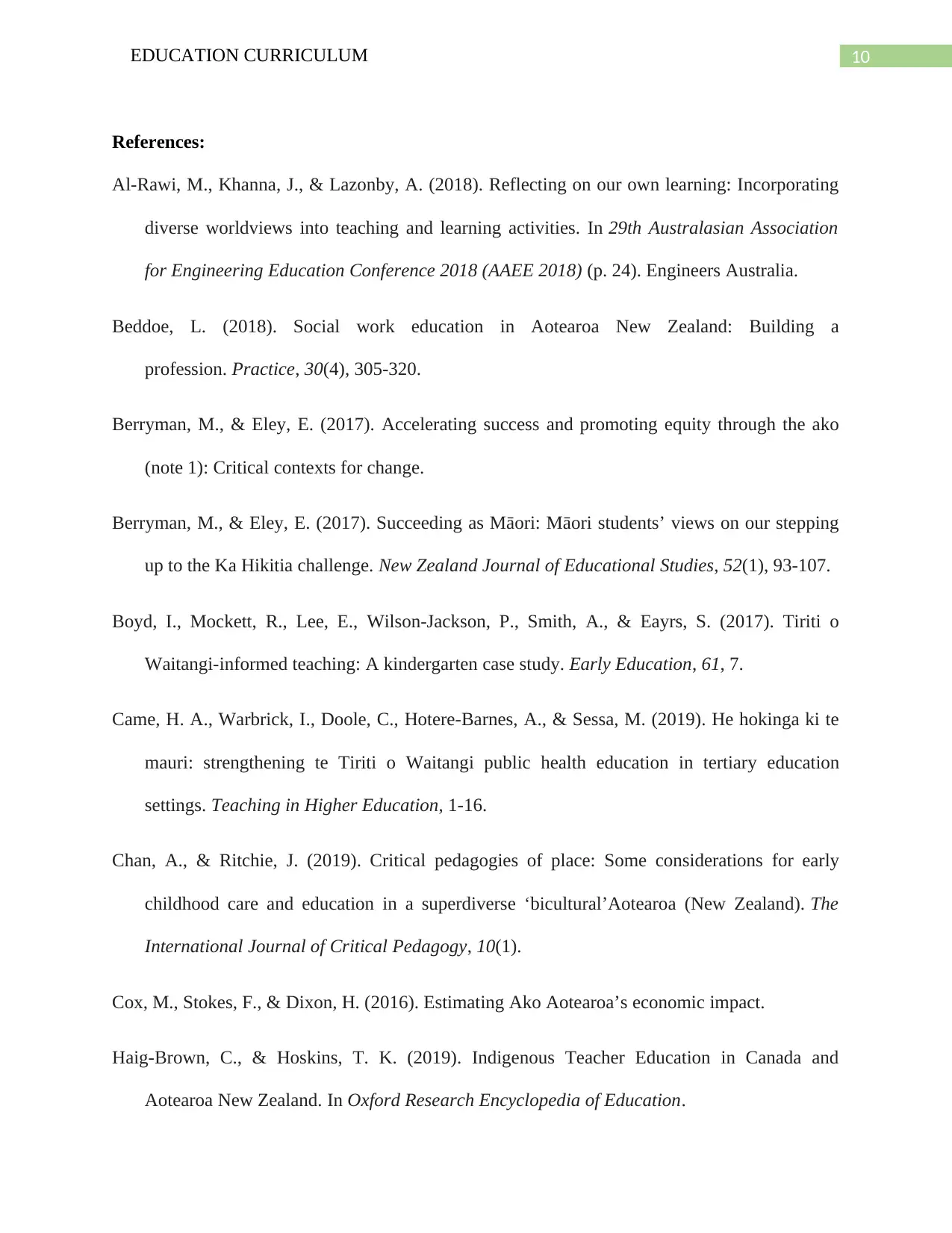
10EDUCATION CURRICULUM
References:
Al-Rawi, M., Khanna, J., & Lazonby, A. (2018). Reflecting on our own learning: Incorporating
diverse worldviews into teaching and learning activities. In 29th Australasian Association
for Engineering Education Conference 2018 (AAEE 2018) (p. 24). Engineers Australia.
Beddoe, L. (2018). Social work education in Aotearoa New Zealand: Building a
profession. Practice, 30(4), 305-320.
Berryman, M., & Eley, E. (2017). Accelerating success and promoting equity through the ako
(note 1): Critical contexts for change.
Berryman, M., & Eley, E. (2017). Succeeding as Māori: Māori students’ views on our stepping
up to the Ka Hikitia challenge. New Zealand Journal of Educational Studies, 52(1), 93-107.
Boyd, I., Mockett, R., Lee, E., Wilson-Jackson, P., Smith, A., & Eayrs, S. (2017). Tiriti o
Waitangi-informed teaching: A kindergarten case study. Early Education, 61, 7.
Came, H. A., Warbrick, I., Doole, C., Hotere-Barnes, A., & Sessa, M. (2019). He hokinga ki te
mauri: strengthening te Tiriti o Waitangi public health education in tertiary education
settings. Teaching in Higher Education, 1-16.
Chan, A., & Ritchie, J. (2019). Critical pedagogies of place: Some considerations for early
childhood care and education in a superdiverse ‘bicultural’Aotearoa (New Zealand). The
International Journal of Critical Pedagogy, 10(1).
Cox, M., Stokes, F., & Dixon, H. (2016). Estimating Ako Aotearoa’s economic impact.
Haig-Brown, C., & Hoskins, T. K. (2019). Indigenous Teacher Education in Canada and
Aotearoa New Zealand. In Oxford Research Encyclopedia of Education.
References:
Al-Rawi, M., Khanna, J., & Lazonby, A. (2018). Reflecting on our own learning: Incorporating
diverse worldviews into teaching and learning activities. In 29th Australasian Association
for Engineering Education Conference 2018 (AAEE 2018) (p. 24). Engineers Australia.
Beddoe, L. (2018). Social work education in Aotearoa New Zealand: Building a
profession. Practice, 30(4), 305-320.
Berryman, M., & Eley, E. (2017). Accelerating success and promoting equity through the ako
(note 1): Critical contexts for change.
Berryman, M., & Eley, E. (2017). Succeeding as Māori: Māori students’ views on our stepping
up to the Ka Hikitia challenge. New Zealand Journal of Educational Studies, 52(1), 93-107.
Boyd, I., Mockett, R., Lee, E., Wilson-Jackson, P., Smith, A., & Eayrs, S. (2017). Tiriti o
Waitangi-informed teaching: A kindergarten case study. Early Education, 61, 7.
Came, H. A., Warbrick, I., Doole, C., Hotere-Barnes, A., & Sessa, M. (2019). He hokinga ki te
mauri: strengthening te Tiriti o Waitangi public health education in tertiary education
settings. Teaching in Higher Education, 1-16.
Chan, A., & Ritchie, J. (2019). Critical pedagogies of place: Some considerations for early
childhood care and education in a superdiverse ‘bicultural’Aotearoa (New Zealand). The
International Journal of Critical Pedagogy, 10(1).
Cox, M., Stokes, F., & Dixon, H. (2016). Estimating Ako Aotearoa’s economic impact.
Haig-Brown, C., & Hoskins, T. K. (2019). Indigenous Teacher Education in Canada and
Aotearoa New Zealand. In Oxford Research Encyclopedia of Education.
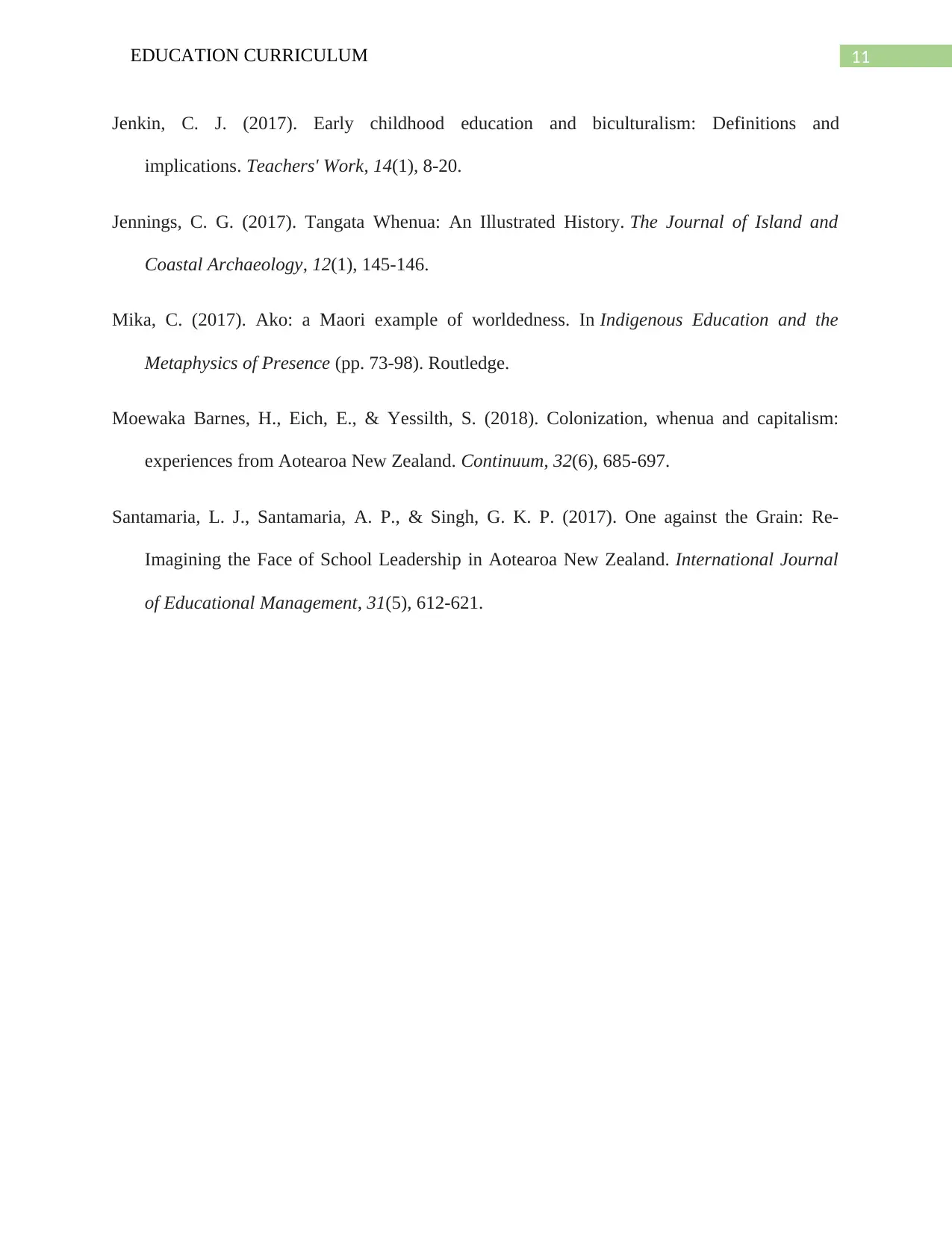
11EDUCATION CURRICULUM
Jenkin, C. J. (2017). Early childhood education and biculturalism: Definitions and
implications. Teachers' Work, 14(1), 8-20.
Jennings, C. G. (2017). Tangata Whenua: An Illustrated History. The Journal of Island and
Coastal Archaeology, 12(1), 145-146.
Mika, C. (2017). Ako: a Maori example of worldedness. In Indigenous Education and the
Metaphysics of Presence (pp. 73-98). Routledge.
Moewaka Barnes, H., Eich, E., & Yessilth, S. (2018). Colonization, whenua and capitalism:
experiences from Aotearoa New Zealand. Continuum, 32(6), 685-697.
Santamaria, L. J., Santamaria, A. P., & Singh, G. K. P. (2017). One against the Grain: Re-
Imagining the Face of School Leadership in Aotearoa New Zealand. International Journal
of Educational Management, 31(5), 612-621.
Jenkin, C. J. (2017). Early childhood education and biculturalism: Definitions and
implications. Teachers' Work, 14(1), 8-20.
Jennings, C. G. (2017). Tangata Whenua: An Illustrated History. The Journal of Island and
Coastal Archaeology, 12(1), 145-146.
Mika, C. (2017). Ako: a Maori example of worldedness. In Indigenous Education and the
Metaphysics of Presence (pp. 73-98). Routledge.
Moewaka Barnes, H., Eich, E., & Yessilth, S. (2018). Colonization, whenua and capitalism:
experiences from Aotearoa New Zealand. Continuum, 32(6), 685-697.
Santamaria, L. J., Santamaria, A. P., & Singh, G. K. P. (2017). One against the Grain: Re-
Imagining the Face of School Leadership in Aotearoa New Zealand. International Journal
of Educational Management, 31(5), 612-621.
⊘ This is a preview!⊘
Do you want full access?
Subscribe today to unlock all pages.

Trusted by 1+ million students worldwide
1 out of 12
Related Documents
Your All-in-One AI-Powered Toolkit for Academic Success.
+13062052269
info@desklib.com
Available 24*7 on WhatsApp / Email
![[object Object]](/_next/static/media/star-bottom.7253800d.svg)
Unlock your academic potential
Copyright © 2020–2025 A2Z Services. All Rights Reserved. Developed and managed by ZUCOL.





